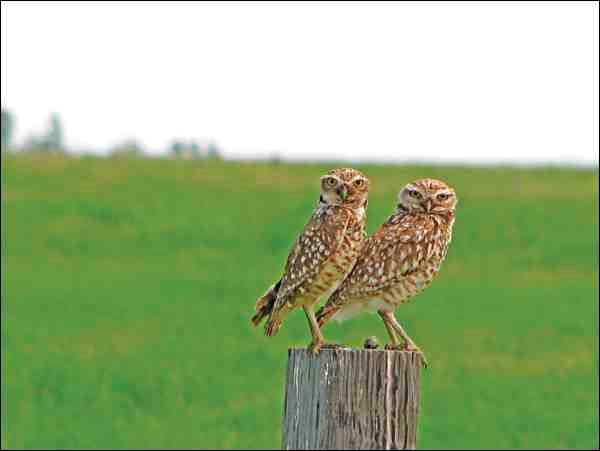The burrowing owl, one of Saskatchewan's best-known species at risk, has returned to Saskatchewan after spending the winter in Mexico and Texas. From mid-May until mid-June, these endangered owls are in the process of finding a mate, building a nest, laying and incubating their eggs.
Despite their name, burrowing owls do not dig out their nests by themselves. Instead, they use abandoned burrows that have been excavated by ground squirrels, badgers or other burrowing mammals. Each spring, female burrowing owls lay six to 12 eggs. Because there are less than 800 pairs nesting throughout Canada, the success of each nest is important to the survival and recovery of the burrowing owl.
To ensure the success of nesting burrowing owls, it is important to minimize human activity around nest sites as much as possible. Cattle grazing, however, is not a disturbance of concern for these owls. Kaytlyn Burrows, Habitat Stewardship co-ordinator, explains: "The shorter grass in grazed pastures helps these owls to sight potential predators. Additionally, burrowing owls often use the manure to absorb excess moisture, regulate burrow temperature, attract insects and hide the owl's scent from predators."
If you discover a pair of burrowing owls nesting in your pasture, do not fear! There are many advantages to having owls on your land, especially the free pest control.
"burrowing owls eat huge numbers of small mammals such as mice and voles, and the young feed primarily on grasshoppers," says Burrows, "In one summer a family of Burrowing Owls can consume 7,000 grasshoppers and 1,800 rodents."
Burrowing Owls are identifiable by their small size (19-25 cm tall), and light and dark brown mottled plumage with white spots. Burrowing owls have very long legs, which can give them the appearance of walking on stilts. They have a round head, with large yellow eyes, and they do not have ear tufts. During the nesting season, male burrowing owls can often be seen standing on mounds of dirt next to their burrows, or on nearby fence posts while the female incubates her eggs.
Nature Saskatchewan's Operation Burrowing Owl works with landowners to promote the protection and enhancement of burrowing owl habitat, and monitors Burrowing Owl populations. If you spot a burrowing owl, please let us know by calling Operation Burrowing Owl at our toll-free Hoot Line at 1-800-667-HOOT (4668). Information is not shared without permission.




